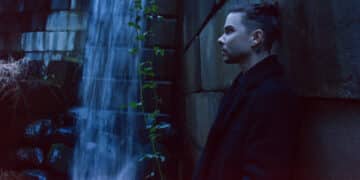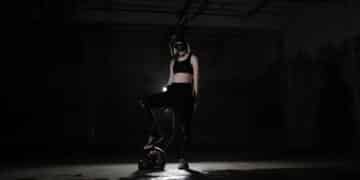In this exclusive interview, Virtual Riot and VJ Neurite delve into their collaborative process and the future of their projects.
Virtual Riot, the alias of German born producer Valentin Brunn, is known for his innovative sound design. Last month, he unveiled his highly anticipated album, Stealing Fire, marking a return to his eclectic roots and showcasing a diverse range of styles beyond his signature dubstep.
We recently had the opportunity to sit down with Val and his VJ, Carmen Aguirre (also known as VJ Neurite) during a Zoom interview. Throughout our conversation, it was evident how much they enjoy working together and building each other up. Their passion for making music and fostering the community around them was palpable.
While Virtual Riot increasingly explores sounds beyond heavy wubs, his personality truly shone through, revealing an artist dedicated to music and his fans. In addition to discussing the new album, Val and Carmen shared exciting news about an upcoming collaboration with none other than Shaquille O’Neal aka DJ Diesel. They hinted at a track featuring Shaq rapping, which is set to be released soon.
Virtual Riot has also just announced his most ambitious headline show to date. On February 8, he will take the stage at the iconic Shrine Auditorium & Expo Hall in Los Angeles. He and VJ Neurite are preparing an immersive experience with enhanced visuals and production that promises to be the biggest show yet. Tickets for that are available now.
The interview that follows is a condensed version of our conversation, where we delved into his journey in music, the inspiration behind Stealing Fire, their collaborative process on and off the stage, and how they navigate relationships within the music industry. Read on below.
Virtual Riot’s new album, Stealing Fire, is out now on all streaming platforms!
Listen to Virtual Riot’ – Stealing Fire on Spotify:
For those who might be unfamiliar, could you share a bit about your journey to becoming Virtual Riot and what drives you as an artist in the dubstep scene and music in general?
Virtual Riot: Yeah, sure. I grew up in Germany, born in 1994, with two older siblings who were a lot older than me. When I was six, they had piano lessons, and I wanted them too because my older siblings were cool, and I wanted to do whatever they did. So I took piano lessons from age 6-16. Around 11 or 12, my brother was studying music production. I found a demo of a basic DAW on a CD in a cereal box — Froot Loops, funnily enough, but it wasn’t [the DAW] FruityLoops.
He got me a copy of Cubase and a MIDI piano, and I started messing around with it for years. At that time, I didn’t know electronic music yet; I was listening to Dream Theater, progressive rock, progressive metal. My brother introduced me to emo and screamo, and then I slowly learned about electronic music. I knew about dubstep, drum and bass, Pendulum, that kind of stuff before Skrillex‘s Scary Monsters and Nice Sprites EP came out, which was life changing for a lot of people. Once that came out, I thought, “Yeah, this is sick. I want to know how to do this.”
I went to university for music production in Mannheim, Germany, which was pretty cool. It was more focused on studio work with drums, microphones, amps, and mixing consoles — not so much on electronic music, but it gave me both sides. I played church organ for a couple of years and eventually started making music and uploading it to SoundCloud. Some labels hit me up; the first one I sought out myself was a very small imprint called Phantom Hertz Recordings. I literally picked them from a list of dubstep labels on Wikipedia because the name sounded cool.
From there, I connected with Joshua Hernandez from Section Z, who managed Savant at the time. He wanted to release whatever I had on my SoundCloud. Then I went to Audiophile, and through them, I connected with Rossy Burr from Disciple. That’s how I started releasing on Disciple before I turned 21. That was when I got my first visa, came to the US, and started playing shows. I moved to Los Angeles and lived with Barely Alive and Dubloadz for a couple of years. Since then, I’ve just been doing this, and it’s been crazy.
You just released your album Stealing Fire. I noticed you’re experimenting with a bunch of different genres beyond dubstep. What inspired you to explore different sounds on this album?
VR: Initially, when I first started putting out music, it was all kinds of different genres and BPMs: glitch, drum and bass, dubstep, electro, house, mid-tempo. I’ve always enjoyed making songs at different speeds and styles. This album is a return to where I came from. When I came to the US and started releasing EPs, everything became more dubstep focused, and then fans would ask, “Where’s the melodic stuff?” When I did melodic stuff, others asked, “Where’s the heavy riddim?” So I decided, “Whatever, I’ll just make what I feel like making.”
That being said, the album turned out a little harder and louder than I expected, which isn’t a bad thing. It gets boring — especially when making an album — if everything is in the same direction. You definitely need to break it up.
Where did the name Stealing Fire come from, and how did it inspire the album?
VR: It was a book I found at Carmen’s house about how humans always look for ways to change their experience of the world, putting ourselves into altered states of mind through video games, gambling, sports, music, dancing, playing an instrument, or drugs. We’re always looking for something to make existence feel less painful. The book compared this to stealing fire from the gods, like in the Greek myth of Prometheus.
I started pondering this imagery and felt that with everything I’ve done — tutorials, sample packs, preset packs — it’s similar. Other producers used to say, “You’re giving all the secrets away, now everyone can do this.” But if you do it right, you make more fire without taking the original away. I just want more people to be able to make cool music.
Also, when I listen to other artists I look up to, I might hear something that sparks an idea. I’m stealing that fire and making more with it. On this album, I’ve sampled records that mean a lot to me or had a big influence on me. It all just made sense.
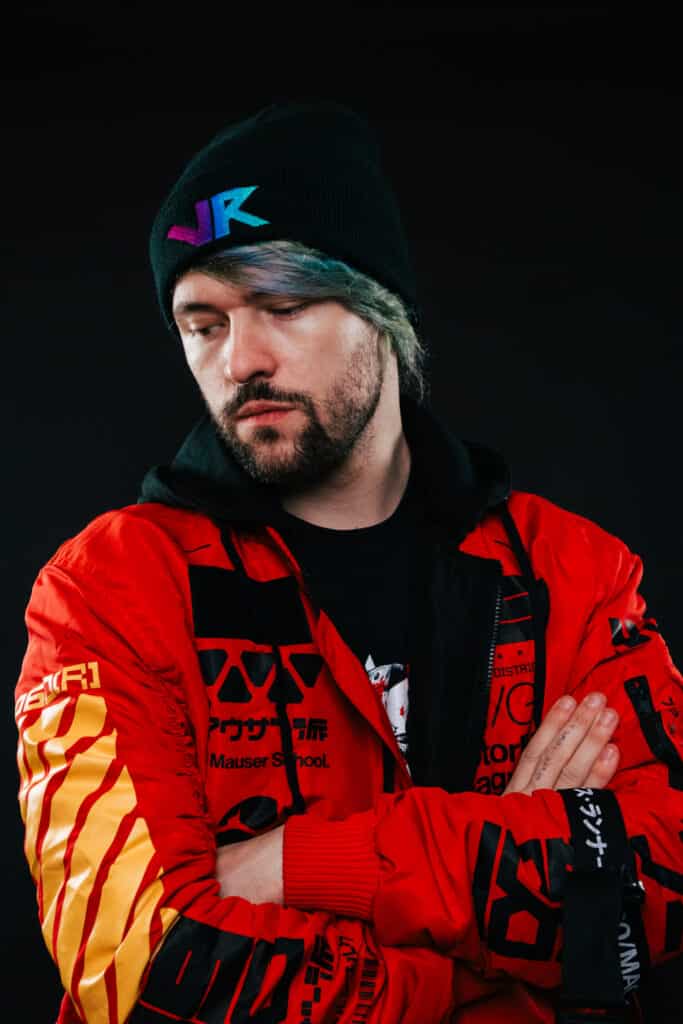
The album features collaborations with artists like Rezz. What was it like working with other artists for this project?
VR: I always love that. I prefer when we can be in the same room. With Isabelle, I was lucky. We were in Toronto and had an extra day, so we met up at deadmau5‘s place, which was really cool. Sometimes collaborating over the internet works too. Mr. Bill is great at sending stems back and forth; he’s so organized.
This album didn’t have as many collaborations or features, overall. Some people pointed that out because I was more hermiting in my room, trying to make something where I could say, “Yeah, this is my stuff.” But it’s cool to have artists like One True God or Raven Grey contribute vocals that elevate the tracks to the next level.
Do you have any other collaborations you’re excited about coming out soon?
VR: [To VJ Neurite] Can we talk about that?
VJ Neurite: We’re still figuring out how it’s going to come out, but there’s a track with Shaquille O’Neal aka Diesel. He’s rapping on it, and he’s killing it. It sounds so sick. It was supposed to be part of the album, but we decided to make it its own thing.
It sounds like you’re both pretty involved with the project. What’s it like working on live shows versus collaborating in other ways?
VJN: Music is all Val; I don’t make any of the music. I handle the visual side of things. We’re very intertwined — we sit down and talk about ideas. I’ll start something and show it to Val, asking where I should take it from there. Sometimes he gives me exports from Cinema 4D that he’s done, and I’ll make an edit that’s timed with those clips.
We work back and forth a lot. Val is very detail oriented, and I like that too. It’s always worked really well. Often, when working with artists, it’s hard to get them interested in their visuals. You’re doing all these tricks, making mood boards, having conversations to pull out their interest. But with Val, it’s a very collaborative process.
On the non creative side, I do half of his management. I handle the merch, advancing, help figure out support for our shows, and work closely with him. I probably call him 14 times a day to ask what he thinks about things. It’s very much a back and forth.
VR: Sometimes with visuals, Carmen just goes and does her thing, and it’s great. For example, she made the lyric visual for the track with Shaq from start to finish, and it’s killer. Sometimes I have an idea for what the screen should show on the drop, and I’ll make a little bit in Cinema 4D, and she takes it from there.
On this tour, we have a light and laser guy for the first time. We had time before our first set to sit down with him, go over songs, and discuss specific laser effects for certain sounds. Dialing this in perfectly and seeing it come to life in the final show is really rewarding.
VJN: We’re very back and forth on that too. We’ll brainstorm ideas with the laser and lighting guy, and it’s awesome to have that collaborative environment. They’ve told us it’s their favorite project they’ve worked on, which is great to hear.
How long have you two been working together?
VJN: Oh boy, about six or seven years. We’ve known each other for seven years and started working on basic visual stuff about six years ago.
Is it always live show visuals, or do you also create visuals for things like Spotify canvases or music videos?
VJN: It depends on the project. We’ve made a few YouTube lyric visuals, but we always use those in live shows. I used to work with Disciple, doing all the animation for releases. Typically, on the label end, an artwork is made, and then they animate that asset. For Spotify and such, that’s usually how it goes. I’m heavily involved in the art process, collaborating with Val and whomever’s making the art. Once the art is figured out, someone — often an animator who works for a label — animates those assets.
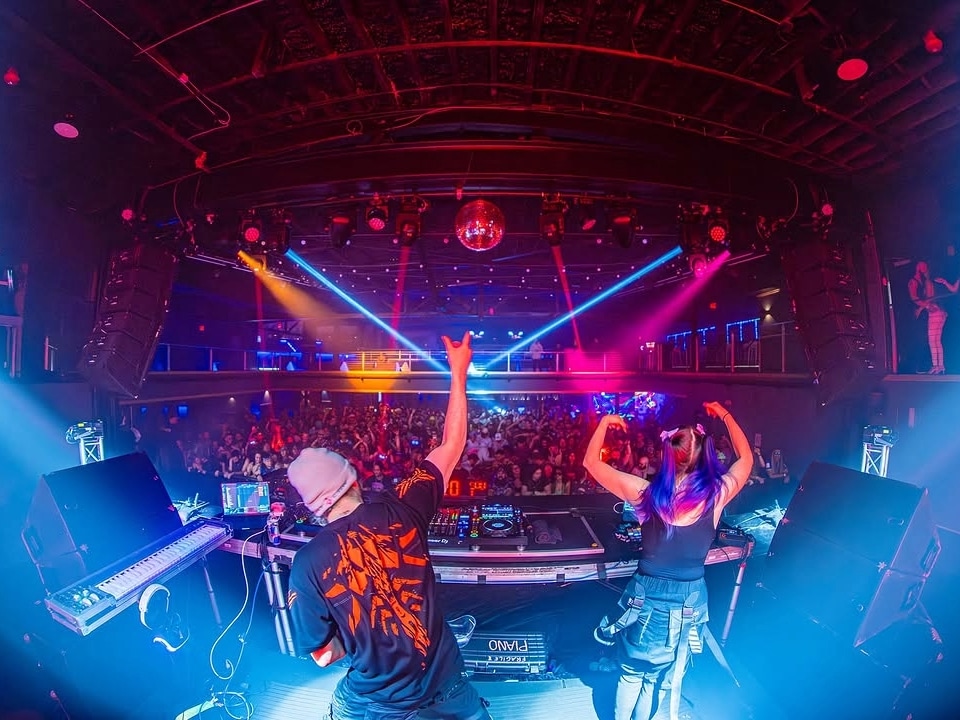
You’re also on stage during most of the performances, right? How’s that experience?
VJN: Yes, I’m on stage for all of them unless there’s a technical reason we can’t. We started doing this about a year and a half ago. We had talked about the idea before, but we thought it might be hard to do. Then we had a gig in China, and they had the VJ on stage. We did the show and had so much fun that we decided we had to keep doing it.
After that, we worked on figuring out the tech behind it. We did a few more shows like that and started coming up with coordinated dance moves. It was easier for us to communicate about set changes, which was important because usually Val would have to text me or rely on show control software, which doesn’t always work.
We also realized that having a VJ on stage brings awareness to production in general and the people who work to put a show together. At Lost Lands this year, people told me they didn’t even know what a VJ was until they saw my reels on Instagram. Now they pay more attention to the visuals, sometimes even more than the music. It’s incredible to hear that and see that what we’re doing is making an impact.
Have other artists reached out to see if they could do something similar for their shows?
VJN: Yeah, I’ve had a lot of VJs ask me about the tech side of things. I had to learn the hard way with shows going wrong, so I’m very open to sharing knowledge, just like Val is. I’ve been hit up by younger artists saying they’re doing a VJ on stage thing too. It’s so cool to see that happening.
That’s really cool. Back to you, Val. What’s most exciting for you right now, both for dubstep and where you want to take Virtual Riot as a project?
V: For the genre, we’re currently at an oversaturation of tearout and loud noises, machine gun bass stabs. It’s very loud and noisy, like who can be the loudest and combine it with the most hype-inducing pre drop samples. There’s also a trend of things getting more minimal, like with Skrillex’s and Fred Again‘s collaboration or the Quest for Fire album. Some people are combining that minimalism with cool songwriting and creative ideas, like the Levitate guys.
I always look for that kind of stuff. I go down rabbit holes on SoundCloud to see what young producers with 200 followers are up to. Many are making really cool stuff and trying something different. I have no idea where the sound for dubstep is going right now.
For me personally, I have this vision in my head from all the music I listened to when I was younger, emo, screamo phases. Many fans of dubstep and EDM were probably scene kids themselves. I’m trying to combine the sound and emotions of that with EDM and festival vibes. It’s something I’m actively working on, and feel like I haven’t fully reached it yet.
Do you have a general idea of the sounds you’re exploring now?
VR: I got an acoustic guitar and an electric guitar to mess around with. I can barely play guitar, but it’s enough when I combine it with messing around in Ableton, chopping it up, and producing it further. I got a mic, I used to sing in bands when I was younger, we had school bands where I played keyboards or sang or both.
The live performance part is something I’ve been trying to bring back with this tour, where we have a keyboard on stage and I do live stuff. Actually doing some kind of live performance feels more rewarding and more like what I want to do. Just DJing, plugging in your USB and playing songs, was more a way to play the music I made at home live. I’m not the DJ who can play any song at any time and react perfectly to the crowd. I remember Feed Me coining the term “producer performer,” and that’s where this is headed.
Are there any shows or festivals you’re hoping to play, or tours you’re looking forward to?
VR: I wish! I’d love to do a tour with a show set that includes a keyboard and brings on vocalists at something like Coachella. That would be really cool. I’d probably sing myself for some of the songs, depending on what’s out by then. I used to make electronic tunes where I was singing, they’re still on my SoundCloud. The first upload on my Virtual Riot SoundCloud is an emo metal rock-inspired thing with synths, guitars, and emo vocals. I love that kind of stuff, and bringing it back with a big live show where featured artists come up and sing would be awesome.
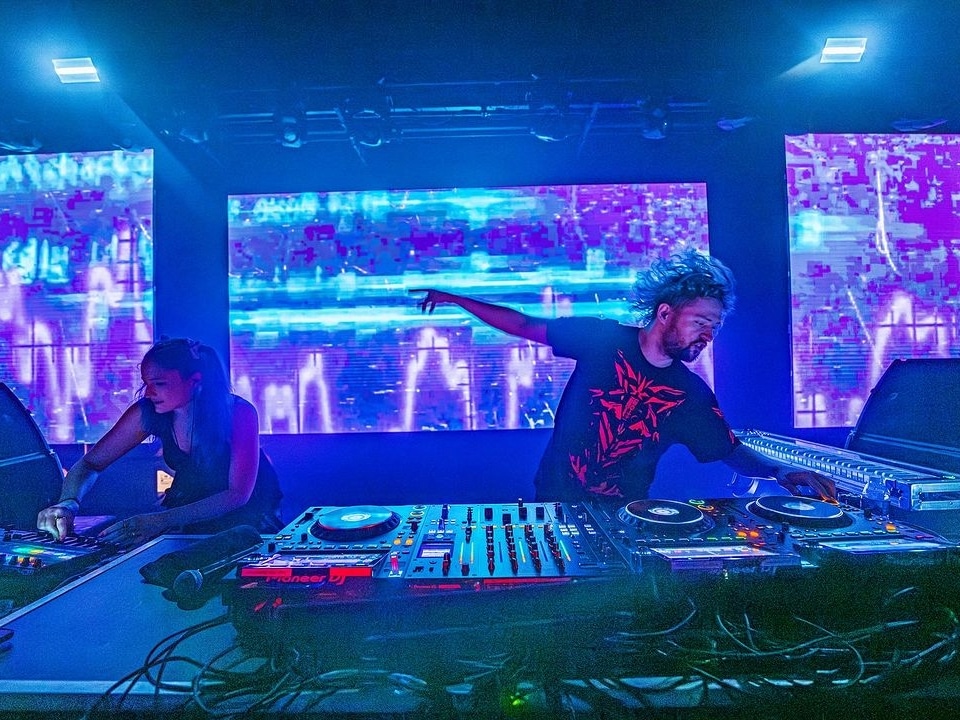
How do you balance things you want to do versus what fans want you to do?
VR: To a high percentage, that overlaps. I hear from many fans that they just want me to do whatever I want to do, which I’m very fortunate to hear. Every time I upload something different on my second SoundCloud account, people say they’d listen to a whole EP of just that. So I can happily include that in the repertoire for the next release.
I even did that when I was 19 or so. The 100% No Bangers EP was three glitch-hop tunes I released for free on Christmas way back. It got millions of plays, and people loved it. It’s always been rewarding to not overthink making something I enjoy and not worry about whether people will like it or if it’s following current trends. I just make what I enjoy, put it out there, and let it resonate with those who like it.
When working with other people in the music industry, how do you navigate those relationships and decide which ones are worth tapping into? How do you decide whom to collaborate with? Is it just gut feeling, or is there anything else?
VR: For me, it’s mostly about whether they’re a cool person, fun to hang out with, and whether what they make is inspiring. If I resonate with what someone is making and feel a connection to their work, I think we can work well together. For example, with the collaboration with Rezz, I’ve always loved mid-tempo music, and she’s one of the few artists who still fronts that genre and does it really well. I started working on something dark and mid-tempo, and I thought combining it with her sound would elevate the track. I’ve always wanted to work with her, so it just came together.
Sometimes I find someone on SoundCloud who’s making really cool stuff, and I want to do something with them. One of my students at Slam Academy did a really cool remix of “This Could Be Us,” and I’ve been playing that live and shouting him out. It depends on whether they’re a good person and if their work is inspiring.
VJN: From a visual perspective, unique style and respect are important. As a female in the industry, if I don’t feel respected in the way someone communicates with me, then collaboration isn’t going to happen. That’s a big one for me because it’s been a journey over the past eight years.
I also value people who are detail oriented and open to feedback about detailed work. Since Val and I are both very detail oriented, it’s important that anyone we work with takes feedback well. This applies to collaborating with animators, laser and lighting technicians, and others. If someone isn’t open to feedback, it can become a nightmare for everyone involved.
On the management side, it’s all about relationships, meetings, getting food and drinks, and who you’re friends with. I’ve been fortunate to know many managers from my time as a VJ, and they’ve been great in offering help, feedback, and helping me make connections with talent buyers. I’m really grateful for that.
Follow Virtual Riot:
Website | Facebook | X | Instagram | SoundCloud | YouTube






